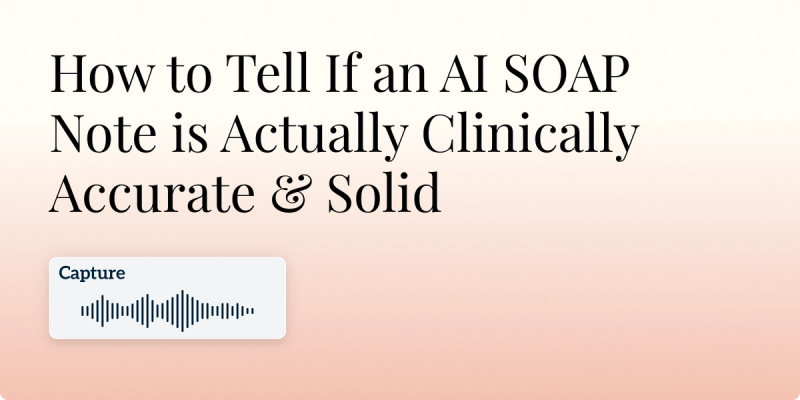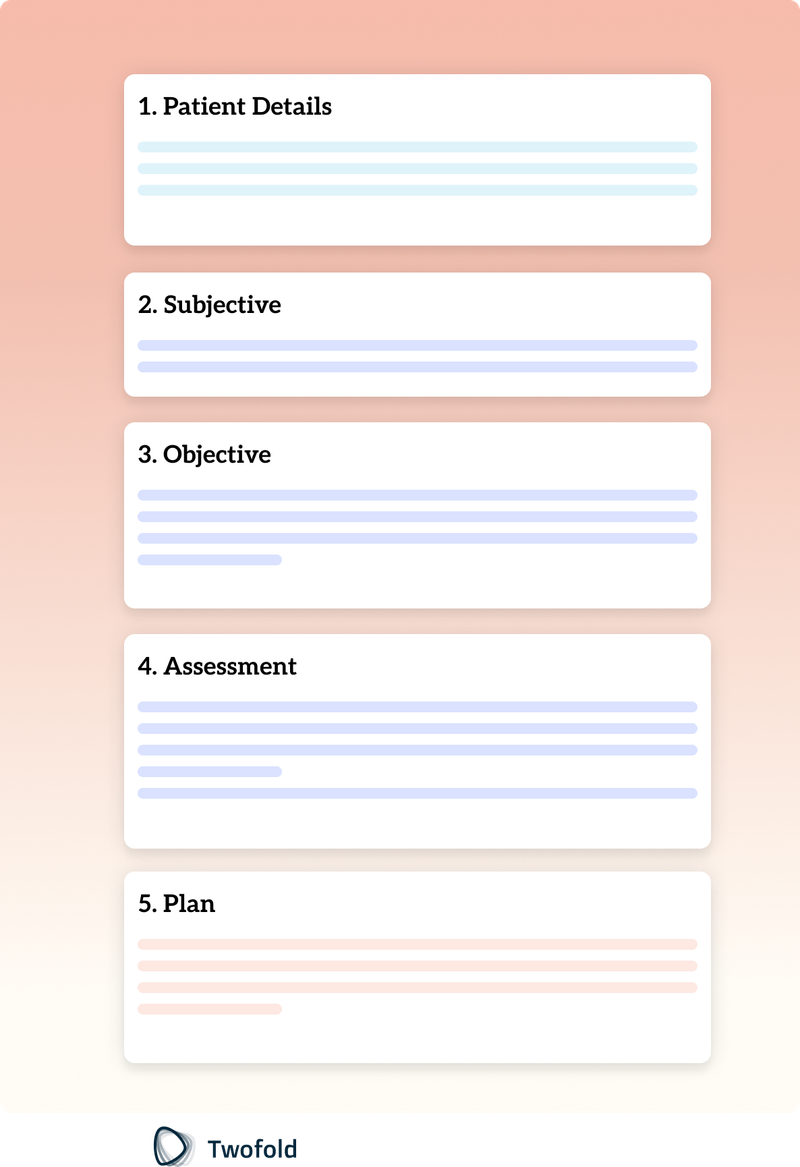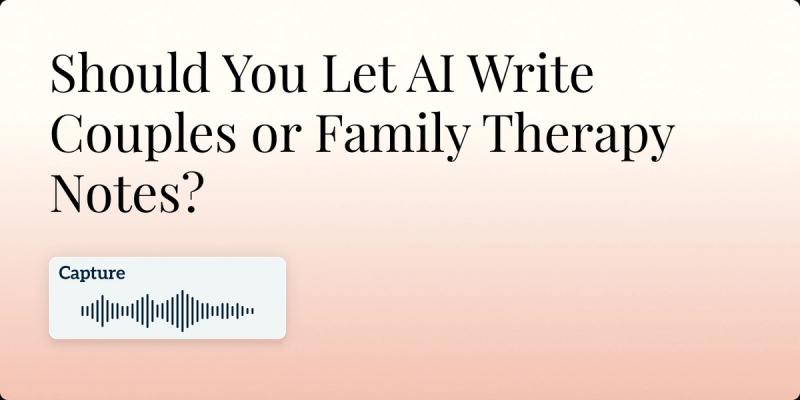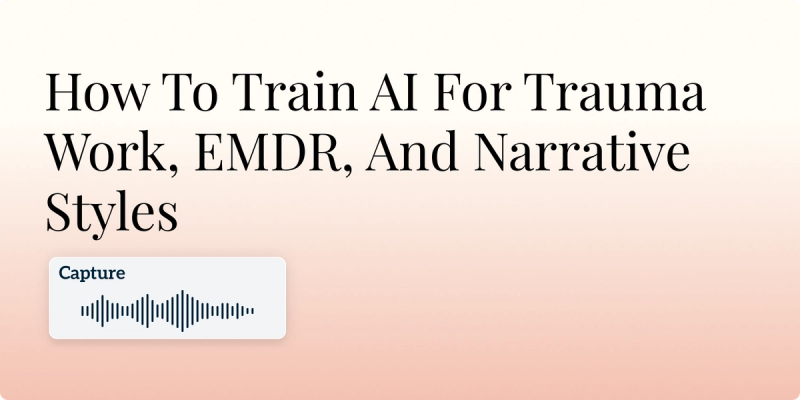
How to Tell If an AI SOAP Note is Actually Clinically Accurate & Solid

AI can churn out a “correct‑looking” SOAP note in seconds. But clinically solid SOAP notes do more than look right, they support decision‑making, continuity, billing standards, and safe patient care across patient encounters. Below is a practical way to judge whether an AI‑generated SOAP note helps you track patient progress and deliver safer care, or just generates text.
Why Clinicians Need More Than Just “Accurate” AI SOAP Notes
Accuracy Alone Isn’t Enough for Patient Care
A note can mirror the conversation yet still be weak for clinical work. A strong SOAP note must include subjective and objective data linked to assessment and plan, not just a transcript. Research on physician documentation quality (e.g., PDQI‑9 and QNOTE) shows that clarity, organization, relevance, and completeness predict usefulness‑ not mere verbatim accuracy.
As one validation paper put it, the PHQ‑9 is “a reliable and valid measure of depression severity,” which matters only if your assessment actually uses it.
Why Clinical Completeness Matters for Continuity
During handoffs, documenting patient encounters with clear objective findings, explicit uncertainty, and next steps reduces blind spots and safety risks. AHRQ notes that standardized handoffs (e.g., SBAR/I‑PASS) improve reliability by making the assessment and recommendation explicit.
Preserving Clinical Nuance and Human Context
Clinical nuance (quotes, patient priorities, risks) prevents wrong inferences later. WHO’s guidance on AI in health stresses human oversight and governance; NIST’s AI RMF calls for systems that are “valid and reliable, safe, secure and resilient” ‑principles that apply to note generation too.
Spotting the Difference: Weak vs. Clinically Solid AI SOAP Notes
Below, soap notes are condensed for readability. Bold shows what the strong version adds.
Example: Incomplete vs. Complete Subjective section
Weak S: “Follow‑up for depression. Feels a bit down. Sleeping ok.”
Solid S:
- CC: “Follow‑up for depression and fatigue.”
- HPI: 2‑month worse mood; anergia, early‑morning awakening; denies SI/HI; PHQ‑9 = 14 (moderate) last week, today = 11; adherence 6/7 days; no med side effects; stressors: job loss; goals: return to regular exercise.
- Pertinent ROS: ↓ concentration; no weight change; headaches improved.
- Medications/Allergies: Sertraline 50 mg daily; NKDA.
Using validated scales (PHQ‑9, GAD‑7 when indicated) strengthens the subjective link to outcomes.
Example: Vague vs. Detailed Assessment
Vague A: “Major depressive disorder, improving.”
Solid A:
- MDD, recurrent, partial response. PHQ‑9 dropped from 14 → 11 in 1 week; sleep better; no SI.
- R/O iron deficiency given fatigue (heavy menses).
- Comorbid GAD suspected; GAD‑7 planned next visit.
- Risk: Low acute suicide risk; will screen with C‑SSRS if PHQ‑9 ≥ 15 or SI items positive.
Example: Generic vs. Actionable Plan
Generic P: “Continue meds. Follow up.”
Solid P:
- Sertraline 50 mg → 75 mg daily; counsel on GI effects; return precautions for SI or activation.
- Labs: CBC, ferritin today.
- Patient education: handout on sleep hygiene; counseling on exercise 3×/week.
- Follow‑up: 2 weeks (med change); repeat PHQ‑9/GAD‑7; document safety plan if scores worsen.
- Care coordination: message PCP re iron studies; share summary with therapist.
These details make the soap note actionable and safer for continuity and patient education.
How to Evaluate an AI SOAP Note for Clinical Quality: Quick Checklist
Use this 60‑second screen before signing any AI‑generated SOAP notes.
Accuracy & Completeness (S/O/A/P)
- S: Chief complaint + HPI + pertinent positives/negatives + med adherence + patient goals
- O: Vital signs, physical examination findings, key labs/imaging with numbers/units
- A: Problem list prioritized; evidence‑based reasoning; differentials & uncertainty stated
- P: Specific orders, monitoring, patient education, return precautions, timeframe, who’s doing what (you, patient, team)
(Adapted from PDQI‑9 and QNOTE dimensions.)
Alignment with Clinical Standards
- Meets E/M documentation expectations for medical necessity and complexity (e.g., G2211 use).
- Uses required elements for interoperability (USCDI data classes) and structured observations where applicable.
Consistency Across Encounters
- Same patient problems are tracked identically over time (terms, measures, goals).
- Prior results and trends are referenced (e.g., PHQ‑9, BP, weight) to track patient progress.
- No “reshuffling” of diagnoses or stray, hallucinated facts between visits. (See NIST’s call for valid/reliable AI outputs).

Key Indicators of a High‑Quality AI SOAP Note
- Clear, Complete, and Relevant Patient History (Subjective): Includes CC, HPI, focused ROS, meds, allergies, context from the patient interaction.
- Correct and Measurable Clinical Findings (Objective): Numbers/units for vitals and tests; concise physical examination findings; structured fields (HL7 FHIR Observation) where your system allows.
- Evidence‑Based Clinical Reasoning (Assessment): Links subjective and objective data to the problem list and differential; references validated tools (e.g., PHQ‑9, GAD‑7, C‑SSRS).
- Actionable, Specific Next Steps (Plan): Orders, monitoring, exact follow‑up, patient education, and contingencies - clear enough for any covering clinician.
- Minimal to No Irrelevant or “Hallucinated” Content: Short, relevant, and faithful to the encounter audio/chart. (NIST AI RMF emphasizes reliability and transparency.)
Common Issues in AI‑Generated SOAP Notes (and How to Spot Them)
- Missing or Incomplete Sections. One letter (often Assessment) is thin or absent. Compare to PDQI‑9/QNOTE criteria.
- Overreliance on Generic Phrasing. “Patient doing fine.” No metrics or thresholds. Require measurable objective findings and targets.
- Inconsistent Tone Across Visits. Diagnoses or meds drift without explanation- check prior notes for continuity. A 2024 study highlights the need to compare notes with what occurred in the encounter itself.
- Incorrect or Ambiguous Abbreviations. Avoid dangerous shorthand; The Joint Commission maintains a “Do Not Use” guidance.
- Privacy and Compliance Oversights. Respect HIPAA’s “minimum necessary” principle; ensure appropriate safeguards (administrative, physical, technical).
Best Practices for Making AI SOAP Notes Clinically Solid
- Use Specialty‑Specific Templates. Behavioral health? Bake in PHQ‑9/GAD‑7/C‑SSRS slots; primary care? routine vitals, ASCVD elements, cancer screening.
- Provide Detailed Prompts to Guide AI Output. Include CC, priorities, red flags, and must‑include measures; require subjective and objective data to connect to the assessment.
- Review and Edit for Clinical Nuance. Quote the patient (“my goal is to…”). Keep sensitive content minimal per minimum necessary.
- Cross‑Check with Patient History. Ensure chronic problems and med lists reconcile with the chart; use standardized data classes (USCDI) when exporting/sharing.
- Give Ongoing Feedback to Refine AI Performance. Organizations rolling out ambient AI document the need for QA programs and human‑in‑the‑loop review.
“Weak vs. Solid” AI SOAP Note at a Glance
Section | Weak AI output | Solid AI output |
|---|---|---|
S | “Follow‑up, doing ok.” | HPI timeline, pertinent negatives, adherence, quantified scales (e.g., PHQ‑9 = 11), patient goals |
O | “Exam normal.” | Vitals with units; focused exam; labs with exact values and dates; links to prior results |
A | “Depression, improving.” | Prioritized problems, evidence‑based reasoning, uncertainty, differentials |
P | “Continue meds; f/u PRN.” | Dose change with rationale; labs/tests; patient education; follow‑up interval & triggers; care coordination |
How Twofold Helps Clinicians Create Clinically Solid AI SOAP Notes
- Specialty‑tuned templates for mental health and primary care encourage complete subjective and objective data, structured objective findings, and validated measures (e.g., PHQ‑9).
- Clinician‑in‑the‑loop editing keeps you in control of the assessment and plan-and supports clear patient education and follow‑ups.
- HIPAA‑aligned safeguards and practical defaults support the minimum necessary standard while you’re documenting patient encounters.
Want to go deeper on AI documentation? See our guides on AI SOAP notes, how to write SOAP notes, and how to write high quality clinic notes.
Conclusion
A clinically solid SOAP note is complete, measurable, and usable by anyone on the care team, today and at the next visit. Hold AI‑generated SOAP notes to the same standard you expect from trainees: explicit linkage from subjective → objective → assessment → plan, alignment with standards (E/M, USCDI), and clarity that supports safe patient care.
Frequently Asked Questions
ABOUT THE AUTHOR
Dr. Eli Neimark
Licensed Medical Doctor
Reduce burnout,
improve patient care.
Join thousands of clinicians already using AI to become more efficient.

Best AI for Therapy Notes (2026)
Discover the best AI for therapy notes in 2026: compare top tools, pricing, HIPAA safeguards, and EHR workflows to cut documentation time and boost accuracy.

Should You Let AI Write Couples or Family Therapy Notes?
AI promises to save therapists hours on notes. But is it safe for sensitive couples and family therapy? Learn the benefits and ethical risks to avoid.

How To Train AI For Trauma Work, EMDR, And Narrative Styles
Learn how to train AI for trauma therapy, EMDR, and narrative styles. Discover ethical prompts, data handling, and customizing AI for sensitive clinical work.

